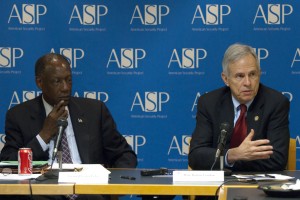
The Future of Fusion
Washington D.C. – On June 5, 2012, the American Security Project hosted top experts from the U.S. fusion community. The full-day symposium focused on the benefits and challenges of fusion energy, and steps towards commercialization. In addition to fusion experts, Retired Air Force General Lester Lyles and former Congressman Barton Gordon (D-TN) were on hand to offer their insights.
General Lyles gave the keynote address, delivering a compelling case for U.S. investment in fusion energy over the long-term. His comments focused on the threat of energy insecurity that looms over the horizon, as global energy demand will continue to rise and fossil fuels will become increasingly expensive to produce. Also, General Lyles expressed his concern over the decline of U.S. global leadership in STEM (Science, Technology, Engineering and Mathematics) education. He noted that investment in the development of fusion energy would mean an investment in America’s human capital. However, as General Lyles noted, “a clear understanding” of the importance of fusion, as well as a wider understanding of the threat that fusion is intended to solve, is needed.
Fusion generates energy by fusing two nuclei of hydrogen together, the same process found in the core of the sun. This is different from nuclear fission, a process of generating energy by splitting atoms, used in conventional nuclear power plants. If developed, fusion would have several benefits.
First, fusion could create a nearly inexhaustible source of energy to meet all of our energy needs for thousands of years. This would make us completely energy independent. Whereas fission reactors use uranium, fusion reactors would use two isotopes commonly found in nature: deuterium, found in seawater, and tritium, which would be generated from lithium.
Second, the only byproducts of the fusion process are helium and neutrons, meaning there is less danger from radioactive waste normally associated with conventional nuclear fission reactors. More importantly, fusion would present minimal concerns about nuclear weapons proliferation since no uranium or plutonium are used in the process.
Third, developing fusion energy at a commercial scale would allow the U.S. to be a global leader in a potentially critical industry, creating enormous opportunities for technology exports. The sophisticated supply chain that would be required to support the fusion industry would be an ample source of new American jobs.
Fourth, a robust fusion industry would have important spillover effects that previous technological breakthroughs experienced. Just as discoveries and innovations in the space industry led to GPS technology and cell phones, advancements in the fusion industry would create new business applications.
Fusion energy holds great promise, and the scientific community is “united” in the belief that its commercialization is possible. But, several challenges remain.
The first problem is scientific. More research and development is needed for the technology to mature, and serious hurdles have to be passed before it is ready for commercial application.
The second problem is more immediate. The industry is under threat from budget cuts from Congress, which could derail ongoing research, dismantle the workforce, and push a date for first ‘burning plasma’ further off into the future. Fusion cuts could spell the end for America’s lead in this industry, as China, South Korea and Japan increase their investments in fusion technology.
Former Congressman Barton Gordon offered his perspective on this challenge. With many areas of scientific research on the chopping block, a clear plan for fusion development is needed, complete with funding requirements and a timeframe for achievable goals. He said that members of Congress need to be able to understand the multiple benefits of fusion to justify funding; benefits to economic growth and job creation, energy independence, national security, and scientific discovery.
The scientific community present at today’s event committed to working together to produce a blueprint for the future of fusion, and was committed to overcoming looming budget cuts.
We will report more on these developments in the coming days and weeks.
In the meantime check out our fusion mini-site here.







[…] You can check out the blog post to this event: the Future of Fusion […]
[…] Cunningham: The Future of Fusion […]
All wrong. Aneutronic DPF micro-plasmoid fusion using hydrogen and boron produces helium and electricity, no neutrons. Costs for completing research and development are fractions of 1% of the funds for toroidal designs. Costs of implementation and output are of the same order.
And, currently, it’s about 10-100X closer to break-even than any other model.
see LPPhysics.com
Commercialization, within about 5 yrs., will be explosive and global. Inexpensive licenses will be sold to all comers. Everywhere.
Brian – thanks for your comments. These alternative fusion types are very interesting, and they deserve serious investment and interest. We think that there is room for a number of competing and collaborative approaches. We take no interest in which one comes first, so long as it meets the requirements to be safe, stable, and sustainable.
[…] The Future of Fusion – American Security Project […]
So why can’t global governments rise above their petty competitiveness and pool their resources? When achieved, fusion technology would be given freely, without license, to the entire world. By working together instead of against each other, the goal will be achieved much more quickly and there will still be plenty of money to be made by all.